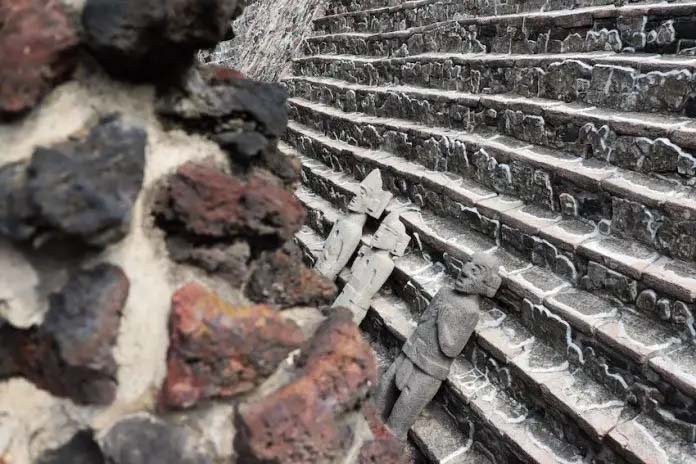by the El Reportero‘s staff and news services
The Templo Mayor archaeological zone, a sacred site in the heart of Mexico City containing remnants from the ancient metropolis of Tenochtitlán, has fully reopened to the public following extensive repairs to its roof, damaged by a rare hailstorm in 2021.
In conjunction with last week’s reopening, there is a new exhibition in the Templo Mayor Museum that includes more than 100 artifacts recently repatriated from the United States — among the more than 14,000 returned to Mexico during the six-year term of President Andrés Manuel López Obrador.
The items on display include stone, ceramic and organic materials that were recovered through an undercover operation by Homeland Security agents in the U.S., according to an Oct. 31 press release from Mexico’s National Institute of Anthropology and History (INAH).
The centerpiece is the “Ce ozomatli” (one monkey) tombstone which was donated to López Obrador last year. The round stone piece, with shell and turquoise inlays, includes the date “ce ozomatli,” indicating a predisposition for crafts and manual labor for those born under this date on the Nahua calendar.
The updated roof — a restoration milestone achieved under a joint project of INAH and the Mexico City government — now shields the oldest remnants of the site, including the shrines dedicated to war and sun god Huitzilopochtli and rain and fertility god Tlaloc, dating back to approximately 1390 AD.
Part of a larger complex and city, the Templo Mayor (Great Temple) was at the center of the political and religious life of the Mexica (Aztec) society. The temple itself consisted of four pyramids and the two shrines where Huitzilopochtli and Tlaloc were venerated with elaborate pageantry and sacrificial offerings.
It was destroyed by Spanish invaders during the Conquest and fall of Tenochtitlán in 1521, and a Catholic cathedral was built with many of the same stones next to where it once stood. A key archeological finding in 1978 helped shed light on the site and the Mexica civilization.
Today the museum includes more than 3,000 important artifacts of Mexica culture.
The new roof installation required careful handling due to the site’s fragile relics and limited accessibility within Mexico City’s historic center.
“The site has not only improved physically, but has regained its relevance in the cultural narrative of the country and, above all, of Mexico City,” INAH Director Diego Prieto Hernández said in a press release. “The preservation of heritage is not limited to techniques and methods. It also involves understanding the meaning that these places have [within] the richness of our history.”
The Oct. 31 reopening also included a Day of the Dead altar dedicated to the states of Guerrero, Oaxaca, Puebla and Veracruz.
Officials said the museum — the third-most visited INAH museum in Mexico City with an average of more than 500,000 visits per year — anticipates a renewed wave of visitors. The exhibit of repatriated items is open daily except Mondays, and will run through February 2025.
With reports from Infobae, El País and La Jornada.



